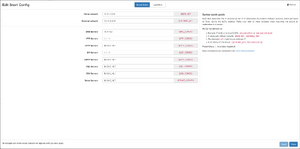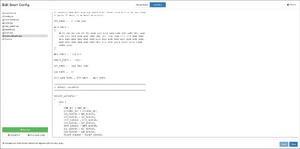Snort
Beta Feature
This feature is still in active development and is therefore subject to changes in the future. There may be bugs or unexpected behavior when using this feature.
Version 4.3.0 of the Allegro Network Multimeter introduced Snort as a new capture method for network traffic. Similar to the Webshark analysis this capture mode does not produce raw packets, but instead sends them to another tool for further processing. With Snort the user is able to conveniently analyze the traffic in their network for potential attacks or intrusions, both live and retroactively.
Configuration
For Snort to function properly it needs to be configured. The multimeter comes pre-equipped with the community ruleset to provide a basic set of rules to cover the most well-known and common attacks in a network. Note that currently no updates are provided for this ruleset by Allegro Packets, instead the user is expected to keep their ruleset up do date themselves.
All configurations of the Snort analysis are done via the Global Settings, under Generic Settings > Snort analysis.
Configuring memory
Snort needs a certain amount of memory to be able to perform the intrusion detection and threat analysis. The more memory Snort is configured to use, the less memory will be available for the in-memory databases of the multimeter. Snort may only use half of the systems memory at max, but generally the software is able to run with less than one gigabyte of memory. The default setting allocates 256MB for the Snort analysis, and generally we do not recommend going too far below this value, as too little memory can cause Snort to hang and crash during analysis. If you experience similar issue, try raising the memory threshold.
Below the slider for maximum memory, a value for "Usable memory" is displayed. This value is a soft memory limit for Snort, which will cause it to be throttled when it reaches it. The usable memory is 5MB below the maximum. If Snort should reach the true maximum memory threshold it will immediately be killed by the OOM manager.
Changing this setting requires a processing restart in order to allocate the configured memory.
Configuring Snort
Beta Feature
Currently there is no proper way to inspect Snort's error output, so invalid configs may result in the Snort analysis seemingly crashing for no reason. At the moment we recommend testing the validity of the configuration with a local Snort installation.
Config
Snort can be configured via Lua scripts which are executed in a sandboxed environment at startup. The multimeter is delivered with the default configuration files of Snort, with the exception that some of the variables have been moved to a new config.lua file. This file is included before everything else.
To learn more about how Snort configuration works, refer to their documentation.
In order to edit this configuration the multimeter provides a web-based interface to either change the config.lua via a GUI, or to edit any configuration file directly. To start editing the configuration click the "Edit config" button. This opens a new modal providing the two editing modes, which can be switched via the buttons at the top center of the window.
Simple editor
This is the first editing mode, and is the one selected by default when opening the config modal. It provides a GUI which allows the user to edit the variables stored in the config.lua. Note that this implies that config.lua is a managed file, which means that directly editing this file is discouraged. As the warning in this file states, editing the values of variables will work fine, however adding new content to the file will cause it to be overridden once the simple editor is used for the next time.
The simple editor provides only a few values that can be edited. Users are encouraged to adjust these values according to their network setup. Setting the home and external network is the only strictly necessary configuration, as the other values are derived from them. The default values for these networks is "any". Refer to the Snort documentation (see above) to find out which values are allowed. Values with a dollar sign ($) in front of them are variables, e.g. setting your DNS servers to $HOME_NET will set the vaule of the DNS servers field to the value of the Home network field. This is the default.
Modifications to these values are not committed until either the "Apply" or "Save" button are pressed. Saving the settings will close the modal, while applying them will commit the changes but keep the modal open. Cancelling will cause all unsaved changes to be discarded (a warning modal will ask for confirmation before discarding).
Lua editor
This is the "advanced" configuration mode for Snort, and is toggled by clicking the appropriate button at the center top of the modal.
This view provides a text editor interface which allows for editing any of the Snort configuration files. The left hand side provides a file browser displaying all files in Snort's configuration folder. This does not necessarily mean that all of these files are used in the configuration. Only files included by an active configuration file are used. The analysis invokes Snort with snort.lua as the config file, so any other config files need to be included either by snort.lua, or one of its included files.
While the config.lua is displayed in this list, it is discouraged to edit it directly.
It is possible to create new files via the button at the bottom of the file list. Hovering over a file reveals two buttons for deleting a file and reloading a file. Deleting a file will mark it for deletion, but that change will not be committed until "Save" or "Apply" are pressed. Reloading a file causes it to be re-fetched from the multimeter and discards all changes to that file. A file can be renamed by selecting it and pressing F2.


